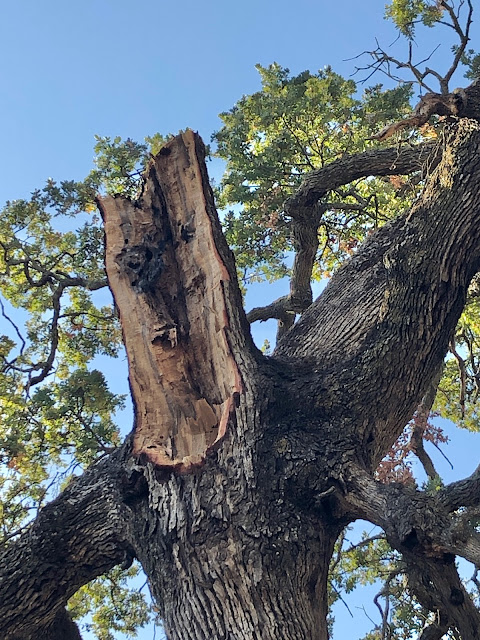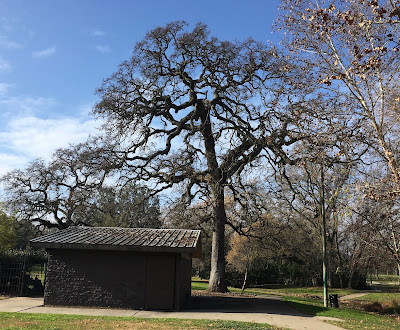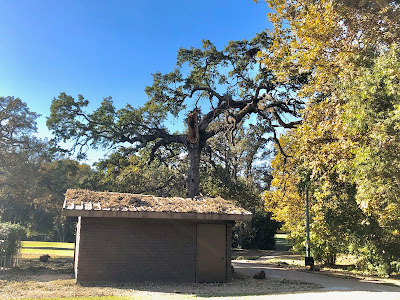
They are more vulnerable than we realize

|
|
This gash was left after a huge limb broke off a blue oak
recently. (Photos: Kathy Morrison)
|
It takes a long time for a mature tree to die.
Yet we've all seen it, maybe without noticing the symptoms. The canopy grows sparse, or it starts dropping leaves and twigs at the wrong time of year, or there are holes all over the trunk. Years may go by before a windstorm blows it over. With the shade in that area now gone, the plants nearby are affected, and maybe the character of the site changes.
Trees are easily taken for granted.
I was reminded of this earlier in the week when I strolled over to our neighborhood park. I hadn't been in awhile, and I always enjoy seeing the changes that fall brings. Also, a flock of magpies lives there, and the birds are amusing to watch.
This park has been part of my landscape for nearly 25 years -- I've photographed most of the trees at one time or another -- so it was a bit of a shock to see a giant wound on my favorite blue oak. This tree stands probably 50 feet tall, just to the side of a small park building that formerly was a restroom and now is a utility room for the park district. A small muddy creek runs nearby about 10 feet away.

|
|
Here's what the full-size blue oak looked like in January 2018.
|
Blue oaks ( Quercus douglasii ) are tough native trees. In the book "Oaks of California" (Cachuma Press), the authors note, "Although other oaks are resistant to drought, few of them combine all the mechanisms of opportunism, conservation, tolerance and resiliency that are known in blue oak." The tree also is one of the "Shady Eighty," trees recommended by the Sacramento Tree Foundation. This particular specimen undoubtably was growing here long before the neighborhood was built in the 1960s.
So why did this giant lose such a big section at this time?

|
|
And here it is earlier this week.
|
This likely is evidence of borer insects, which years ago sensed a stressed tree and made this oak their home. Clearwing moths are among the insects whose larvae leave dime-size tunnels in trees, but it could have been another pest. SacTree notes of the blue oak: "Wood and root rots occur, borers and chewing insects can also be a problem."
Whatever caused the branch to weaken and break, this tree may not survive the injury. The remaining canopy, with the exception of one other smaller branch, still sported the tree's distinctive blue-green leaves. But since the tree stands next to a public walkway, it may pose too much of a liability to remain where it's grown for so many years. If it goes, I will miss it. Its fate also serves as an excellent reminder to care for our trees, before we're forced to notice them.
If you have questions about caring for any trees, not just oaks, the Sacramento Tree Foundation is an excellent source of information: sactree.org
Comments
0 comments have been posted.Sacramento Digs Gardening to your inbox.
Food in My Back Yard Series
May 6: Maintain soil moisture with mulch for garden success
April 29: What's (already) wrong with my tomato plants?
April 22: Should you stock up on fertilizer? (Yes!)
April 15: Grow culinary herbs in containers
April 8: When to plant summer vegetables
April 1: Don't be fooled by these garden myths
March 25: Fertilizer tips: How to 'feed' your vegetables for healthy growth
March 18: Time to give vegetable seedlings some more space
March 11: Ways to win the fight against weeds
March 4: Potatoes from the garden
Feb. 25: Plant a fruit tree now -- for later
Feb. 18: How to squeeze more food into less space
Feb. 11: When to plant? Consider staggering your transplants
Feb. 4: Starting in seed starting
Sites We Like
Garden Checklist for week of May 4
Enjoy this spring weather – and get gardening!
* Plant, plant, plant! It’s prime planting season in the Sacramento area. Time to set out those tomato transplants along with peppers and eggplants. Pinch off any flowers on new transplants to make them concentrate on establishing roots instead of setting premature fruit.
* Direct-seed melons, cucumbers, summer squash, corn, radishes, pumpkins and annual herbs such as basil.
* Harvest cabbage, lettuce, peas and green onions.
* In the flower garden, direct-seed sunflowers, cosmos, salvia, zinnias, marigolds, celosia and asters. (You also can transplant seedlings for many of the same flowers.)
* Plant dahlia tubers. Other perennials to set out include verbena, coreopsis, coneflower and astilbe.
* Transplant petunias, marigolds and perennial flowers such as astilbe, columbine, coneflowers, coreopsis, dahlias, rudbeckia and verbena.
* Keep an eye out for slugs, snails, earwigs and aphids that want to dine on tender new growth.
* Feed summer bloomers with a balanced fertilizer.
* For continued bloom, cut off spent flowers on roses as well as other flowering plants.
* Add mulch to the garden to maintain moisture. Mulch also cuts down on weeds. But don’t let it mound around the stems or trunks of trees or shrubs. Leave about a 6-inch to 1-foot circle to avoid crown rot or other problems.